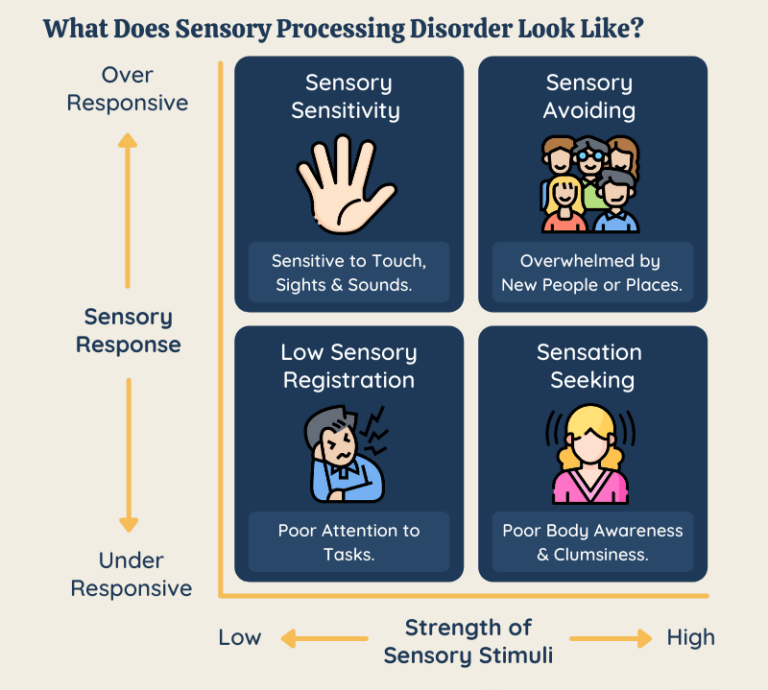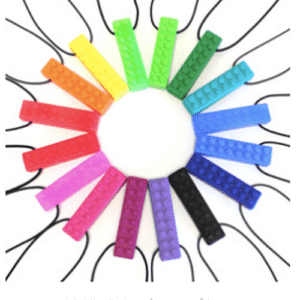These can be signs of something known as sensory processing disorder.
When we receive input to one of our senses (such as touch, sound, sight, smell, or taste), our brain has to take in, interpret it, and form a response. When we can do that in an appropriate way, we’re “well-modulated”.
But some children have trouble regulating their senses. That can cause them to have difficulties interacting and participating in certain environments. Those children may have a sensory processing disorder.
Children with sensory processing disorder have been shown to have difficulties with behavior and learning.
In order to help your child, it’s important to first understand the details of what sensory processing disorder is. Here’s all of the need-to-know information, including what to do if you suspect your child has sensory processing disorder.
Defining Sensory Processing Disorder
Sensory Processing Disorder is a neurological condition in which the brain has difficulty organizing information it receives from the senses.
Vestibular: movement, balance, and gravity. Having control over this sense helps maintain coordination as we move our body.
Proprioception: also known as kinesthesia. This is how we perceive where our body parts are located, how they are moving (the action), and the degree of force being used.
Interoception: feeling and understanding what is happening inside of your body. This might be knowing and controlling feelings of being hungry, cold, or having butterflies in your stomach when you’re nervous.
Causes
SPD is common, with 1 in 6 children estimated to experience symptoms of sensory processing difficulties that interfere with how they function daily.
What to Look For
Here are some signs of sensory processing disorder seen in children:
Hypersensitivity: the brain over-responds to stimuli
- Notices sounds others may ignore
- Covers ears for certain sounds
- Does not like busy/crowded environments
- Dislikes hands being messy
- Sensitivity to tastes (ex: certain textures or flavors)
- Bothered by tags on clothing, the feeling of certain types of clothing, or seams on socks
- Does not like swinging or certain movements
- May avoid touch
Hyposensitivity: the brain has an under-response to stimuli
- Seeks sensory input because of a higher threshold
- Constant movement/difficulty sitting still
- Rocking, hand flapping
- Enjoys spinning
- Often touches other people or feels things around them
- Likes to watch certain lights or objects move a certain way (may enjoy holding objects close to their eyes or looking at them from a certain angle)
- Poor body awareness, which can display as clumsiness
How to Help
Having sensory processing disorder can cause a lot of difficulties for a child during their everyday life. Children may have lower academic performance and difficulty paying attention in a classroom.
SPD, when not addressed during childhood, is associated with issues in adulthood like anxiety, depression, and inattention.
Occupational Therapy: OT can provide something known as sensory integration therapy. Depending on the child’s needs, activities in OT provide certain types of sensory input or modifications that can help his or her system become better regulated.
Sensory diet: This is a customized plan developed by an OT with activities recommended for the child. It might include things like having the child jump on the trampoline (for vestibular input), or using a therapy brush daily (similar to a massage) for a child who is hypersensitive to touch.
Accommodations: Parents can look for ways to accommodate a child’s sensory needs to help them stay more well regulated. Buying tagless shirts, getting a swing for the backyard, or giving an item meant to be chewed on are some examples.
Additional Resources
Sensory processing disorder can affect a child’s ability to function in everyday life, personally and academically. Parents can help a child who has sensory needs by making certain accommodations and seeking the appropriate treatment.
TherapyWorks offers speech therapy, occupational and physical therapy both in person (in Illinois, Michigan, and Ohio) and through teletherapy (nationwide). If you would like to learn more, or discuss your child’s specific needs, please don’t hesitate to reach out to TherapyWorks!











